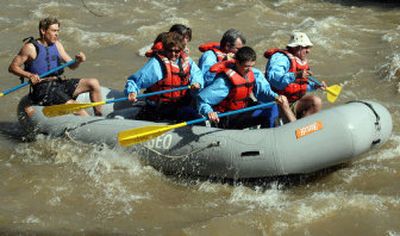Rafting outfits hope to run record season

IDAHO SPRINGS, Colo. – Bountiful snow – melting faster than a Sno-Cone amid a heat wave in parts of the West – has delivered enough water this spring to have many rafting outfitters hoping for a record season.
The exception is companies in the Southwest, which have been plagued by a persistent drought.
The nation’s rafting industry, like skiing and other outdoor businesses, is dependent on natural resources. Outfitters keep a close eye how much snow falls; how fast it will melt to feed rivers (too warm and the melting snow goes by in a flash; too slow and it could delay the season); and how full reservoirs are.
Although slow to rebound from the travel downturn after the Sept. 11 attacks, the industry has largely recovered since. David Brown, executive director of trade group America Outdoors, said companies in the West are making a more significant recovery than those in the East, where demand has been flat and in some cases declining.
The industry began to rebound after the 2001 attacks, then was slowed some by the economic fallout from the beginning of the Iraq war. Then, while the West took off in 2004-05, in part helped by its myriad tourist destination spots, the East suffered through wet, cool weather that dampened visits.
“It’s still possible you’re going to see that bounce-back this year in the East because you have some hot weather,” Brown said. “It’s become a last-minute market. … People wait for the weather report.”
The association does not track revenue on a national level, but Brown said there are about 3 million to 4 million user visits annually. A user visit is an industry figure that refers to a rafter who pays for all or part of one day’s trip.
Colorado is the most popular state for rafting, with the Arkansas River in the south-central part of the state the most popular waterway, Brown said.
Outfitters on the state’s 13 major river systems are hoping to beat the record of 525,537 user visits set in 1999. A record $135 million in revenue was collected last year, according to the Colorado River Outfitters Association.
“We are busier than we’ve been in past seasons, and from what I see out on the rivers I think most of my fellow outfitters would probably second that,” said Bruce Becker, a member of the organization and owner of GEO Tours in Morrison, just west of Denver. “Several of our rivers are kind of reaching their peak levels right now, and consequently, the hot weather we’ve been having has really been bringing the people out.”
Similar high hopes are held by outfitters from the Pacific Northwest to Montana, with some saying business has been up significantly.
“It’s looking phenomenal,” said Mark Zoller, owner of Outdoor Odysseys Inc. in south-central Washington who is projecting a 25 percent increase in user visits this season.
Bob Jordan, owner of Wild River Adventures in West Glacier, Mont., said he is expecting more visitors from Canada because of the strengthening exchange rate for the Canadian dollar but did not want to offer a prediction for the season.
John Wood, president of Holiday Expeditions in Utah, said the season’s start has been “just right,” but he is worried that high gasoline prices will pose a challenge.
“We operate in very remote locations that require two-and-a-half- to three-hour drives to the put-ins,” Wood said. “And we think we see it in our other major cost, and that is food.”
Outfitters in the Southwest note that revenue and customers are down for a number of reasons, including the drought that has left many rivers with low water levels.
Brown of the national trade association said many businesses are coping with lower water levels with different activities and devices such as inflatable kayaks that allow customers to paddle their own boats.
In New Mexico, the Rio Grande River was running at nearly 5,000 cubic feet per second around the community of Pilar during the Memorial Day weekend of 2005. This year, the rate is slightly more than 400 cfs.
Business for Far Flung Adventures of Taos, N.M., was down substantially in May but began picking up this month, owner Steve Harris said.
“It’s not a big raging runoff, but it’s certainly been runnable,” he said. “Instead of plunging over big wave trains, we run through chutes between rocks and little drops. That’s still fun.”